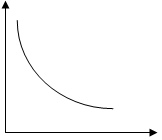Factors affecting the total market demand
These are broadly divided into the determinants of demand and conditions of demand.
(a) Own price of the product
This is the most important determinant of demand. The determinants of demand other than price are referred to as the conditions of demand.
Changes in the price of a product bring about changes in quantity demanded, such that when the price falls more is demanded. This can be illustrated mathematically as follows:
Qd = a - bp
Where Qd is quantity demanded
a is the factor by which price changes
p is the price
Thus, ceteris paribus, there is an inverse relationship between price and quantity demanded. Thus the normal demand curve slopes downwards from left to right as follows:

Exceptional demand curves
There are exceptions when more is demanded when the price increases. These happens in the case of:
(i) Inferior goods: Cheap necessary foodstuffs provide one of the best examples of exceptional demand. When the price of such a commodity increases, the consumers may give up the less essential compliments in an effort to continue consuming the same amount of the foodstuff, which will mean that he will spend more on it. He may find that there is some money left, and this he spends on more of the foodstuff and thus ends up consuming more of it than before the price rise. A highly inferior good is called Giffen good after Sir Robert Giffen.
(ii) Articles of ostentation (snob appeal or conspicuous consumption): There are some commodities that appear desirable only if they are expensive. In such cases the consumer buys the good or service to show off or impress others. When the price rises, it becomes more impressive to consume the product and he may increase his consumption. Some articles of jewellery, perfumes- and fashion goods fall in this category.
(iii) Speculative demand: If prices are rising rapidly, a rise in price may cause more of a commodity to be demanded for fear that prices may rise further. Alternatively, people may buy hoping to resell it at higher prices. In all these three cases, the demand curve will be positively sloped i.e. the higher the price, the greater the quantity bought. These demand curves are called reverse demand curves (also called perverse or abnormal demand curve).
(b) Prices of other related commodities.
Related commodities can be compliments or substitutes.
(i) Compliments: The compliments of a commodity are those used or consumed with it. Suppose commodities A and B are compliments, and the price of A increased. This will lead to a fall in the quantity demanded of A, and will in turn lead to a fall in the demand for B. Example are bread and butter or cars and petrol.
(ii) Substitutes: The substitutes of a commodity are those that can be used or consumed in the place of the commodity. Suppose commodities X and Y are substitutes. If the price of X increases, the quantity demanded of X falls, and the demand for Y increases.
(c) The Aggregate National Income and its distribution among the population. In normal circumstances as income goes up the quantity demanded goes up. In such a case the good is called a normal good. However, there are certain goods whose demand shall increase with income up to a certain point, then remain constant. In such a case the good is called a necessity e.g. salt. Also there are some goods whose demand shall increase with income up to a certain point then fall as the income continues to increase. In such a case the good is called an inferior good.
(d) Taste and preference
There is a direct relationship between quantity demanded and taste. For instance, if consumers' taste and preferences change in favour of a commodity, demand will increase. On the other hand, if taste and preferences change against the commodity e.g. due to changes in fashion, demand will fall. Taste and preferences are influenced by religion, community background, academic background, environment, etc.
(e) Expectation of future price changes
If it is believed that the price of a commodity is likely to be higher in the future than at present, then even though the price has already risen, more of the commodity may be bought at the higher price.
(g) Climatic/seasonal factors
Seasonal variations affect the demand of certain commodities such as cold drinks like sodas and heavy clothing.
(h) The size and structure of population
Changes in population overtime affect the demand for a commodity. Also as population increases, the population structure changes in such away that an increasing proportion of the population consists of young age group. This will lead to a relatively higher demand for those goods and services consumed mostly by young age group e.g. fashions, films, nightclubs, schools, toys, etc.
(i) Government influences
e.g. a legislation requiring the wearing of seatbelts.
(j) Advertising especially the persuasive ones